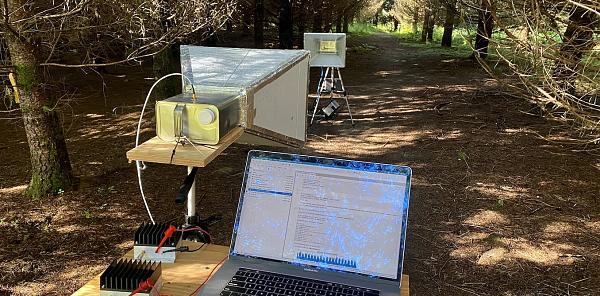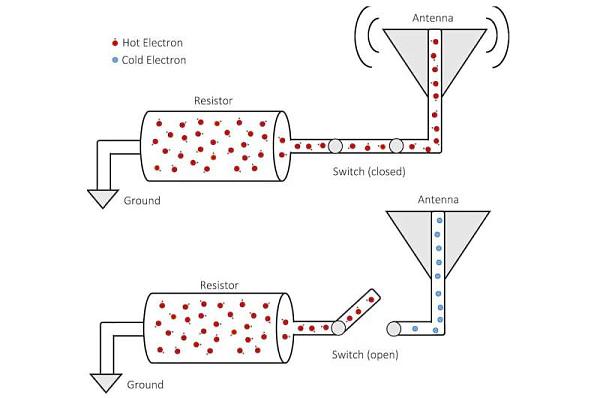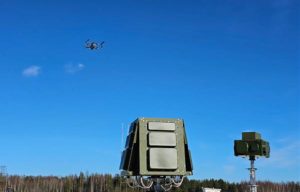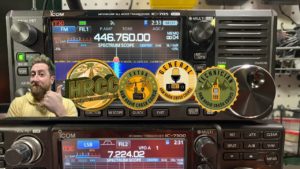New technology for low-power radio communications works without consuming power

A group of scientists and engineers from Stanford and Washington universities has developed a new technology for low-power radio communications that, at first glance, violates some of the basic laws of physics. Information in this system is transmitted by closing and opening an electronic key, a transistor that connects a resistor to an antenna of a certain configuration. No additional energy is supplied to the transmitting antenna itself.
In conventional radio systems, there are also similar keys or their more complex counterparts, called modulators. These keys connect the outputs of high frequency sine generators to a transmitting antenna or an intermediate power amplifier
But the new system does not require a signal generator; instead, it uses random thermal noise from the thermal motion of free electrons in each electronic component. In this case, the role of the electronic component is a special resistor, and a transistor with no moving parts is used as a switch, so all the power consumption on the transmitter side is very small, required just to switch the transistor.
But the new system does not require a signal generator, and instead uses random thermal noise from each electronic component due to the thermal motion of free electrons
It all looks so incredible that during the peer review of this achievement, the reviewers asked the researchers to provide an explanation of how the operation of this system does not violate the second law of thermodynamics. For if this law were violated, a new kind of perpetual motion machine would have been invented, which, as we know very well, is fundamentally impossible
Signal transmission principle
And then another peculiarity of this system was revealed. According to one of the interpretations of the second law of thermodynamics, heat can flow randomly from a hotter object to a colder one. In this case the role of heat flow is played by the transmitted signal, carrying information, and the receiver of the signal works as a refrigerator. And while the transmitter consumes almost no energy, on the receiver side it is consumed in quite significant amounts, on the order of two watts
So, in terms of physics, the new system is not a perpetual motion machine at all. And given that all the power consumption happens on the receiver side of some base station, where there are usually no power problems, this technology looks very viable
And if you combine that low-energy data transmission capability with methods of getting energy from the environment, it opens up completely new possibilities for creating miniature sensors, contactless credit cards, implantable medical devices, and so on that don’t need batteries or other power sources.
And if you combine the ability to transmit data in a low-energy way with methods of getting energy from the environment, it opens up completely new possibilities for creating miniature sensors, contactless credit cards, implantable medical devices, and so on without needing batteries or other power sources
In their future work, the researchers plan to increase the data transfer rate, extend the range of the system and test all this with real devices, the first of which will be medical implants. These devices will no longer use a separate resistor as a signal source, but thermal noise occurring directly in living tissues
No free lunch
We are electrical engineers who research wireless systems. During a review of our paper on this research, recently published in the Proceedings of the National Academy of Sciences, reviewers asked us to explain why the method does not violate the second law of thermodynamics, the basic law of physics that explains why perpetual motion engines are impossible.
We are engineers in the field of electrical engineering
Perpetual engines are theoretical machines that can run indefinitely without requiring energy from any external source. The reviewers worried that if you could send and receive information without powered components and with a transmitter and receiver at the same temperature, it would mean you could create a perpetual motion machine. Since that’s not possible, it would mean that there was something wrong with our work or our understanding of it
One way to formulate the second law is that heat spontaneously flows only from hotter objects to cooler objects. Wireless signals from our transmitter carry heat. If there were a spontaneous flow of signal from the transmitter to the receiver in the absence of a temperature difference between them, you could collect that flow to get free energy, in violation of the second law.
If there were a spontaneous flow of signal from the transmitter to the receiver in the absence of a temperature difference between them, you could collect that flow to get free energy, in violation of the second law
The solution to this seeming paradox is that the receiver in our system works like a refrigerator. The electrons carrying the signal at the receiving end are efficiently cooled by a powerful amplifier, just as a refrigerator keeps the cold inside by continually pumping out heat. The transmitter uses almost no power, but the receiver draws a significant amount of power, up to 2 watts. This is similar to receivers in other ultra-low-power communications systems. Almost all of the power consumption occurs at the base station, which has no power usage limits.
Simpler approach
Many researchers around the world are studying a related passive communication technique known as backscattering. A backscatter data transmitter is very similar to our data transmitter device. The difference is that in a backscatter communication system, in addition to the data transmitter and data receiver, there is a third component that generates the radio wave. The switching performed by the data transmitter results in the reflection of this radio wave, which is then picked up by the receiver.
The backscatterer has the same energy efficiency as our system, but the backscatter setup is much more complex because it requires a signal-generating component. However, our system has a lower data rate and range than backscatter radios or conventional radios.
The backscatter system is much more energy efficient, but the backscatter setup is much more complex because it requires a signal-generating component
Detailed description in scientific paper: Zerina Kapetanovic et al, Communication by means of modulated Johnson noise, Proceedings of the National Academy of Sciences (2022). DOI: 10.1073/pnas.2201337119
If you have found a spelling error, please, notify us by selecting that text and pressing Ctrl+Enter.








